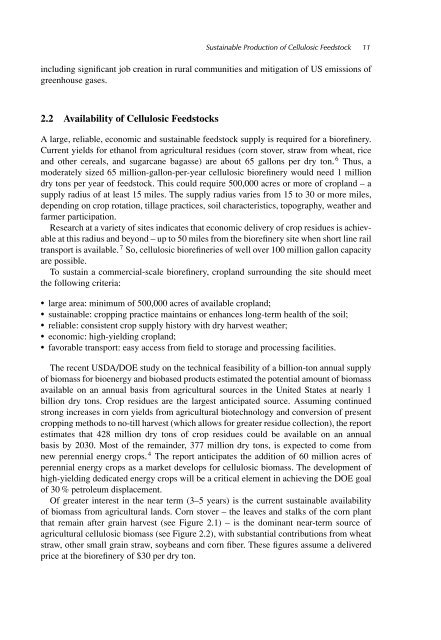Biofuels in Perspective
Biofuels in Perspective
Biofuels in Perspective
You also want an ePaper? Increase the reach of your titles
YUMPU automatically turns print PDFs into web optimized ePapers that Google loves.
Susta<strong>in</strong>able Production of Cellulosic Feedstock 11<br />
<strong>in</strong>clud<strong>in</strong>g significant job creation <strong>in</strong> rural communities and mitigation of US emissions of<br />
greenhouse gases.<br />
2.2 Availability of Cellulosic Feedstocks<br />
A large, reliable, economic and susta<strong>in</strong>able feedstock supply is required for a bioref<strong>in</strong>ery.<br />
Current yields for ethanol from agricultural residues (corn stover, straw from wheat, rice<br />
and other cereals, and sugarcane bagasse) are about 65 gallons per dry ton. 6 Thus, a<br />
moderately sized 65 million-gallon-per-year cellulosic bioref<strong>in</strong>ery would need 1 million<br />
dry tons per year of feedstock. This could require 500,000 acres or more of cropland – a<br />
supply radius of at least 15 miles. The supply radius varies from 15 to 30 or more miles,<br />
depend<strong>in</strong>g on crop rotation, tillage practices, soil characteristics, topography, weather and<br />
farmer participation.<br />
Research at a variety of sites <strong>in</strong>dicates that economic delivery of crop residues is achievable<br />
at this radius and beyond – up to 50 miles from the bioref<strong>in</strong>ery site when short l<strong>in</strong>e rail<br />
transport is available. 7 So, cellulosic bioref<strong>in</strong>eries of well over 100 million gallon capacity<br />
are possible.<br />
To susta<strong>in</strong> a commercial-scale bioref<strong>in</strong>ery, cropland surround<strong>in</strong>g the site should meet<br />
the follow<strong>in</strong>g criteria:<br />
� large area: m<strong>in</strong>imum of 500,000 acres of available cropland;<br />
� susta<strong>in</strong>able: cropp<strong>in</strong>g practice ma<strong>in</strong>ta<strong>in</strong>s or enhances long-term health of the soil;<br />
� reliable: consistent crop supply history with dry harvest weather;<br />
� economic: high-yield<strong>in</strong>g cropland;<br />
� favorable transport: easy access from field to storage and process<strong>in</strong>g facilities.<br />
The recent USDA/DOE study on the technical feasibility of a billion-ton annual supply<br />
of biomass for bioenergy and biobased products estimated the potential amount of biomass<br />
available on an annual basis from agricultural sources <strong>in</strong> the United States at nearly 1<br />
billion dry tons. Crop residues are the largest anticipated source. Assum<strong>in</strong>g cont<strong>in</strong>ued<br />
strong <strong>in</strong>creases <strong>in</strong> corn yields from agricultural biotechnology and conversion of present<br />
cropp<strong>in</strong>g methods to no-till harvest (which allows for greater residue collection), the report<br />
estimates that 428 million dry tons of crop residues could be available on an annual<br />
basis by 2030. Most of the rema<strong>in</strong>der, 377 million dry tons, is expected to come from<br />
new perennial energy crops. 4 The report anticipates the addition of 60 million acres of<br />
perennial energy crops as a market develops for cellulosic biomass. The development of<br />
high-yield<strong>in</strong>g dedicated energy crops will be a critical element <strong>in</strong> achiev<strong>in</strong>g the DOE goal<br />
of 30 % petroleum displacement.<br />
Of greater <strong>in</strong>terest <strong>in</strong> the near term (3–5 years) is the current susta<strong>in</strong>able availability<br />
of biomass from agricultural lands. Corn stover – the leaves and stalks of the corn plant<br />
that rema<strong>in</strong> after gra<strong>in</strong> harvest (see Figure 2.1) – is the dom<strong>in</strong>ant near-term source of<br />
agricultural cellulosic biomass (see Figure 2.2), with substantial contributions from wheat<br />
straw, other small gra<strong>in</strong> straw, soybeans and corn fiber. These figures assume a delivered<br />
price at the bioref<strong>in</strong>ery of $30 per dry ton.








